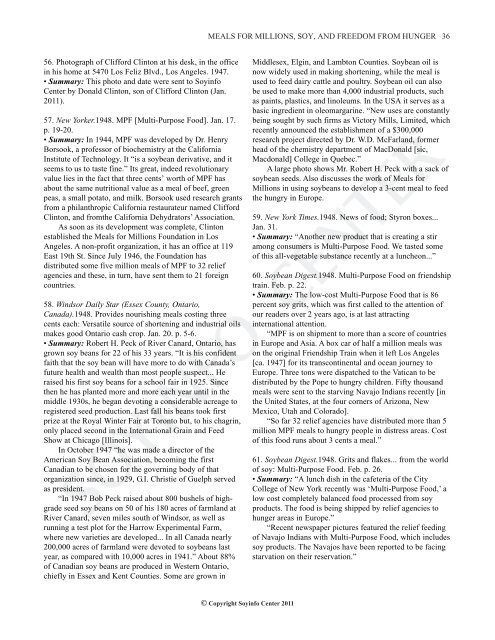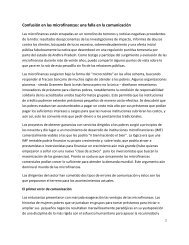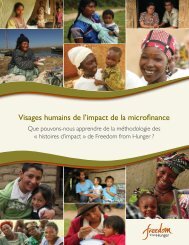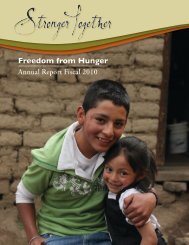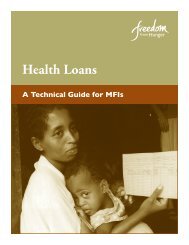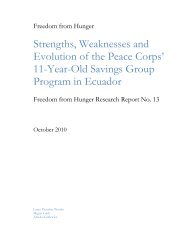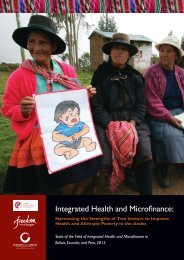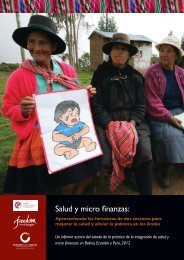history of meals for millions, soy, and freedom from ... - SoyInfo Center
history of meals for millions, soy, and freedom from ... - SoyInfo Center
history of meals for millions, soy, and freedom from ... - SoyInfo Center
Create successful ePaper yourself
Turn your PDF publications into a flip-book with our unique Google optimized e-Paper software.
56. Photograph <strong>of</strong> Clif<strong>for</strong>d Clinton at his desk, in the <strong>of</strong>fice<br />
in his home at 5470 Los Feliz Blvd., Los Angeles. 1947.<br />
• Summary: This photo <strong>and</strong> date were sent to Soyinfo<br />
<strong>Center</strong> by Donald Clinton, son <strong>of</strong> Clif<strong>for</strong>d Clinton (Jan.<br />
2011).<br />
57. New Yorker.1948. MPF [Multi-Purpose Food]. Jan. 17.<br />
p. 19-20.<br />
• Summary: In 1944, MPF was developed by Dr. Henry<br />
Borsook, a pr<strong>of</strong>essor <strong>of</strong> biochemistry at the Cali<strong>for</strong>nia<br />
Institute <strong>of</strong> Technology. It “is a <strong>soy</strong>bean derivative, <strong>and</strong> it<br />
seems to us to taste fine.” Its great, indeed revolutionary<br />
value lies in the fact that three cents’ worth <strong>of</strong> MPF has<br />
about the same nutritional value as a meal <strong>of</strong> beef, green<br />
peas, a small potato, <strong>and</strong> milk. Borsook used research grants<br />
<strong>from</strong> a philanthropic Cali<strong>for</strong>nia restaurateur named Clif<strong>for</strong>d<br />
Clinton, <strong>and</strong> <strong>from</strong>the Cali<strong>for</strong>nia Dehydrators’ Association.<br />
As soon as its development was complete, Clinton<br />
established the Meals <strong>for</strong> Millions Foundation in Los<br />
Angeles. A non-pr<strong>of</strong>it organization, it has an <strong>of</strong>fice at 119<br />
East 19th St. Since July 1946, the Foundation has<br />
distributed some five million <strong>meals</strong> <strong>of</strong> MPF to 32 relief<br />
agencies <strong>and</strong> these, in turn, have sent them to 21 <strong>for</strong>eign<br />
countries.<br />
58. Windsor Daily Star (Essex County, Ontario,<br />
Canada).1948. Provides nourishing <strong>meals</strong> costing three<br />
cents each: Versatile source <strong>of</strong> shortening <strong>and</strong> industrial oils<br />
makes good Ontario cash crop. Jan. 20. p. 5-6.<br />
• Summary: Robert H. Peck <strong>of</strong> River Canard, Ontario, has<br />
grown <strong>soy</strong> beans <strong>for</strong> 22 <strong>of</strong> his 33 years. “It is his confident<br />
faith that the <strong>soy</strong> bean will have more to do with Canada’s<br />
future health <strong>and</strong> wealth than most people suspect... He<br />
raised his first <strong>soy</strong> beans <strong>for</strong> a school fair in 1925. Since<br />
then he has planted more <strong>and</strong> more each year until in the<br />
middle 1930s, he began devoting a considerable acreage to<br />
registered seed production. Last fall his beans took first<br />
prize at the Royal Winter Fair at Toronto but, to his chagrin,<br />
only placed second in the International Grain <strong>and</strong> Feed<br />
Show at Chicago [Illinois].<br />
In October 1947 “he was made a director <strong>of</strong> the<br />
American Soy Bean Association, becoming the first<br />
Canadian to be chosen <strong>for</strong> the governing body <strong>of</strong> that<br />
organization since, in 1929, G.I. Christie <strong>of</strong> Guelph served<br />
as president.<br />
“In 1947 Bob Peck raised about 800 bushels <strong>of</strong> highgrade<br />
seed <strong>soy</strong> beans on 50 <strong>of</strong> his 180 acres <strong>of</strong> farml<strong>and</strong> at<br />
River Canard, seven miles south <strong>of</strong> Windsor, as well as<br />
running a test plot <strong>for</strong> the Harrow Experimental Farm,<br />
where new varieties are developed... In all Canada nearly<br />
200,000 acres <strong>of</strong> farml<strong>and</strong> were devoted to <strong>soy</strong>beans last<br />
year, as compared with 10,000 acres in 1941.” About 88%<br />
<strong>of</strong> Canadian <strong>soy</strong> beans are produced in Western Ontario,<br />
chiefly in Essex <strong>and</strong> Kent Counties. Some are grown in<br />
MEALS FOR MILLIONS, SOY, AND FREEDOM FROM HUNGER 36<br />
© Copyright Soyinfo <strong>Center</strong> 2011<br />
Middlesex, Elgin, <strong>and</strong> Lambton Counties. Soybean oil is<br />
now widely used in making shortening, while the meal is<br />
used to feed dairy cattle <strong>and</strong> poultry. Soybean oil can also<br />
be used to make more than 4,000 industrial products, such<br />
as paints, plastics, <strong>and</strong> linoleums. In the USA it serves as a<br />
basic ingredient in oleomargarine. “New uses are constantly<br />
being sought by such firms as Victory Mills, Limited, which<br />
recently announced the establishment <strong>of</strong> a $300,000<br />
research project directed by Dr. W.D. McFarl<strong>and</strong>, <strong>for</strong>mer<br />
head <strong>of</strong> the chemistry department <strong>of</strong> MacDonald [sic,<br />
Macdonald] College in Quebec.”<br />
A large photo shows Mr. Robert H. Peck with a sack <strong>of</strong><br />
<strong>soy</strong>bean seeds. Also discusses the work <strong>of</strong> Meals <strong>for</strong><br />
Millions in using <strong>soy</strong>beans to develop a 3-cent meal to feed<br />
the hungry in Europe.<br />
59. New York Times.1948. News <strong>of</strong> food; Styron boxes...<br />
Jan. 31.<br />
• Summary: “Another new product that is creating a stir<br />
among consumers is Multi-Purpose Food. We tasted some<br />
<strong>of</strong> this all-vegetable substance recently at a luncheon...”<br />
60. Soybean Digest.1948. Multi-Purpose Food on friendship<br />
train. Feb. p. 22.<br />
• Summary: The low-cost Multi-Purpose Food that is 86<br />
percent <strong>soy</strong> grits, which was first called to the attention <strong>of</strong><br />
our readers over 2 years ago, is at last attracting<br />
international attention.<br />
“MPF is on shipment to more than a score <strong>of</strong> countries<br />
in Europe <strong>and</strong> Asia. A box car <strong>of</strong> half a million <strong>meals</strong> was<br />
on the original Friendship Train when it left Los Angeles<br />
[ca. 1947] <strong>for</strong> its transcontinental <strong>and</strong> ocean journey to<br />
Europe. Three tons were dispatched to the Vatican to be<br />
distributed by the Pope to hungry children. Fifty thous<strong>and</strong><br />
<strong>meals</strong> were sent to the starving Navajo Indians recently [in<br />
the United States, at the four corners <strong>of</strong> Arizona, New<br />
Mexico, Utah <strong>and</strong> Colorado].<br />
“So far 32 relief agencies have distributed more than 5<br />
million MPF <strong>meals</strong> to hungry people in distress areas. Cost<br />
<strong>of</strong> this food runs about 3 cents a meal.”<br />
61. Soybean Digest.1948. Grits <strong>and</strong> flakes... <strong>from</strong> the world<br />
<strong>of</strong> <strong>soy</strong>: Multi-Purpose Food. Feb. p. 26.<br />
• Summary: “A lunch dish in the cafeteria <strong>of</strong> the City<br />
College <strong>of</strong> New York recently was ‘Multi-Purpose Food,’ a<br />
low cost completely balanced food processed <strong>from</strong> <strong>soy</strong><br />
products. The food is being shipped by relief agencies to<br />
hunger areas in Europe.”<br />
“Recent newspaper pictures featured the relief feeding<br />
<strong>of</strong> Navajo Indians with Multi-Purpose Food, which includes<br />
<strong>soy</strong> products. The Navajos have been reported to be facing<br />
starvation on their reservation.”


